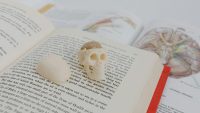You might not immediately link subtle symptoms to your gallbladder, but unusual upper right abdominal pain or persistent digestive discomfort after meals can signal trouble. Changes in stool or urine color and signs of infection like fever should prompt attention, as they often indicate gallbladder dysfunction. Recognizing these less obvious signs early helps prevent complications, yet many overlook them until issues worsen. Understanding what to watch for can make a vital difference.
Unexplained Upper Right Abdominal Pain
Although upper right abdominal pain can have various causes, unexplained discomfort in this area often points to gallbladder problems.
You might experience sharp or dull pain that sometimes radiates to your back or shoulder blades. This pain often results from gallbladder inflammation, especially when gallstones block bile flow. You may notice abdominal tenderness when pressing on the area, indicating irritation.
The pain can worsen after eating fatty foods because your gallbladder contracts to release bile. If the pain comes on suddenly and severely, it could signal biliary colic, which requires prompt medical attention.
Ignoring persistent pain might lead to chronic gallbladder inflammation or dysfunction, so it’s important to monitor your symptoms carefully and seek evaluation if discomfort continues or worsens.
Persistent Digestive Distress After Meals
Persistent digestive distress after meals can signal that your gallbladder isn’t functioning properly. When your gallbladder struggles to release bile effectively, fat digestion suffers, leading to bloating, gas, and nausea, especially after fatty foods.
If you frequently experience these symptoms or chronic indigestion, it’s important to monitor how your body reacts to different meals. While bloating remedies and gas relief may provide temporary comfort, they don’t address the underlying issue.
You should pay close attention to symptom patterns, including feelings of fullness or acid reflux, which often accompany gallbladder problems. Identifying triggers and seeking medical evaluation can help prevent further complications.
Understanding these signs early allows for timely intervention, improving your digestive health and overall well-being.
Noticeable Changes in Stool and Urine Color
How can changes in stool and urine color signal gallbladder problems?
When your gallbladder isn’t working properly, bile flow can get blocked, leading to noticeable shifts in stool color. Pale or clay-colored stools often mean bile isn’t reaching your intestines as it should, which may indicate a bile duct blockage.
At the same time, your urine color can darken due to excess bile pigments entering the bloodstream and then being filtered by your kidneys. These changes suggest your body is struggling to process bile normally.
Additionally, unusual bowel habits like frequent diarrhea after meals can further point to gallbladder dysfunction.
Monitoring stool color and urine color changes is essential because they serve as early warning signs of gallbladder disease that deserve prompt medical evaluation.
Signs of Infection Including Fever and Chills
When you experience fever or chills along with abdominal pain, it can indicate an infection in your gallbladder that needs prompt attention.
These infection symptoms often signal gallbladder inflammation or blockage, which may allow bacteria to multiply and cause serious complications.
Fever and chills occur in about one-third of people with gallbladder inflammation, making them important signs to monitor closely.
Ignoring these symptoms can lead to the infection spreading throughout your body, increasing the risk of life-threatening conditions like peritonitis.
If you notice a rising body temperature alongside abdominal discomfort, seek immediate medical evaluation.
Early diagnosis and treatment are essential to prevent the infection from worsening and to protect your overall health.
Frequently Asked Questions
Can Gallbladder Problems Cause Shoulder or Back Pain?
Yes, gallbladder problems can cause shoulder or back pain because of referred pain. When your gallbladder function is impaired, pain signals can travel to nearby nerves, making you feel discomfort in those areas.
Is Nausea After Fatty Meals Always Related to the Gallbladder?
No, nausea after fatty meals isn’t always related to your gallbladder. Fatty meal effects can trigger nausea from various causes like indigestion or acid reflux. You should monitor your symptoms and consult a doctor for proper diagnosis.
How Does Gallbladder Dysfunction Affect Gas and Bloating?
Gallbladder dysfunction can cause gallbladder gas and bloating symptoms because your body struggles to digest fats properly. When bile flow is disrupted, you’ll often experience uncomfortable gas buildup and persistent bloating after meals.
Can Gallbladder Issues Impact Appetite or Cause Weight Loss?
Yes, gallbladder issues can cause appetite changes and lead to weight fluctuations. You might lose your appetite due to pain or nausea, which can result in unintentional weight loss if you don’t address the problem early.
Are There Any Unusual Skin Changes Linked to Gallbladder Disease?
Yes, you might notice skin discoloration or persistent itching sensations if your gallbladder isn’t working right. These unusual skin changes can signal bile flow issues, so don’t ignore them and see your doctor promptly.





